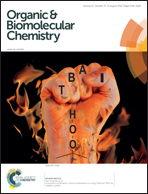Monitoring and inhibition of Plk1: amphiphilic porphyrin conjugated Plk1 specific peptides for its imaging and anti-tumor function†
Abstract
Polo-like kinase 1 (Plk1) is well-known for taking part in cell cycle progression and regulation. Using small molecules for Plk inhibition has been well documented in the literature. However, there are several intrinsic and intractable problems associated with this approach. For example monitoring small molecule Plk inhibitors as anti-tumor agents in vitro/in vivo is often ineffective, they can have poor cell internalization and be susceptible to enzymatic degradation. Herein, we report the synthesis of cell-permeable, water-soluble amphiphilic porphyrin – Plk1 specific peptide bioconjugates, Por-P1 and Por-P2. In addition to resolving the aforementioned problems of the small molecule inhibitors Por-P2 manifests responsive emission enhancement upon binding with Plk1 in aqueous medium and in vitro, while potently triggering G2-M phase arrest and then apoptosis selectively in the cancer cells tested. In combination our findings make Por-P2 a promising candidate for the preparation of a new generation of smart chemotherapeutic targeting agents (imaging and inhibition) for Plk1 in particular cancer cell lines.


 Please wait while we load your content...
Please wait while we load your content...